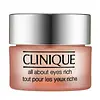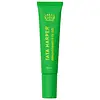What's inside
What's inside
 Key Ingredients
Key Ingredients

 Benefits
Benefits

 Concerns
Concerns

 Ingredients Side-by-side
Ingredients Side-by-side

Water
Skin ConditioningButyrospermum Parkii Butter
Skin ConditioningCetearyl Alcohol
EmollientButylene Glycol
HumectantHydrogenated Polyisobutene
EmollientPhenyl Trimethicone
Skin ConditioningPolyglyceryl-3 Beeswax
EmulsifyingPolybutene
Sucrose
HumectantCetyl Esters
EmollientPolymethyl Methacrylate
Isostearyl Neopentanoate
EmollientGlycerin
HumectantCetearyl Glucoside
EmulsifyingTocopheryl Acetate
AntioxidantTriticum Vulgare Germ Extract
Skin ConditioningHordeum Vulgare Extract
EmollientSigesbeckia Orientalis Extract
Skin ConditioningPEG-100 Stearate
Usnea Barbata Extract
Betula Alba Bud Extract
Skin ConditioningPolysilicone-11
Methyl Glucose Sesquistearate
EmollientCamellia Sinensis Leaf Extract
AntimicrobialSalvia Officinalis Leaf
MaskingGlyceryl Polymethacrylate
Yeast Extract
Skin ConditioningGentiana Lutea Root Extract
Skin ConditioningStearic Acid
CleansingMilk Protein
Skin ConditioningLactis Proteinum
Skin ConditioningPalmitoyl Oligopeptide
CleansingSqualane
EmollientMagnesium Ascorbyl Phosphate
AntioxidantCholesterol
EmollientCaffeine
Skin ConditioningPEG-8
HumectantPhytosphingosine
Skin ConditioningAcrylates/C10-30 Alkyl Acrylate Crosspolymer
Emulsion StabilisingAminomethyl Propanol
BufferingDimethicone
EmollientIsomerized Linoleic Acid
Skin ConditioningLinoleic Acid
CleansingSodium Hyaluronate
Humectant1,2-Hexanediol
Skin ConditioningDecarboxy Carnosine Hcl
Skin ConditioningPotassium Sulfate
Caprylyl Glycol
EmollientDisodium EDTA
Sodium Dehydroacetate
PreservativePhenoxyethanol
PreservativeCI 19140
Cosmetic ColorantMica
Cosmetic ColorantIron Oxides
CI 77891
Cosmetic ColorantWater, Butyrospermum Parkii Butter, Cetearyl Alcohol, Butylene Glycol, Hydrogenated Polyisobutene, Phenyl Trimethicone, Polyglyceryl-3 Beeswax, Polybutene, Sucrose, Cetyl Esters, Polymethyl Methacrylate, Isostearyl Neopentanoate, Glycerin, Cetearyl Glucoside, Tocopheryl Acetate, Triticum Vulgare Germ Extract, Hordeum Vulgare Extract, Sigesbeckia Orientalis Extract, PEG-100 Stearate, Usnea Barbata Extract, Betula Alba Bud Extract, Polysilicone-11, Methyl Glucose Sesquistearate, Camellia Sinensis Leaf Extract, Salvia Officinalis Leaf, Glyceryl Polymethacrylate, Yeast Extract, Gentiana Lutea Root Extract, Stearic Acid, Milk Protein, Lactis Proteinum, Palmitoyl Oligopeptide, Squalane, Magnesium Ascorbyl Phosphate, Cholesterol, Caffeine, PEG-8, Phytosphingosine, Acrylates/C10-30 Alkyl Acrylate Crosspolymer, Aminomethyl Propanol, Dimethicone, Isomerized Linoleic Acid, Linoleic Acid, Sodium Hyaluronate, 1,2-Hexanediol, Decarboxy Carnosine Hcl, Potassium Sulfate, Caprylyl Glycol, Disodium EDTA, Sodium Dehydroacetate, Phenoxyethanol, CI 19140, Mica, Iron Oxides, CI 77891
Hordeum Vulgare Leaf Juice
EmollientPropanediol
SolventGlycerin
HumectantWater
Skin ConditioningCarthamus Tinctorius Seed Oil
MaskingC10-18 Triglycerides
EmollientMica
Cosmetic ColorantCI 77891
Cosmetic ColorantC9-12 Alkane
SolventGlyceryl Stearate Citrate
EmollientLauryl Laurate
Skin ConditioningSqualane
EmollientCaffeine
Skin ConditioningTerminalia Arjuna Extract
Skin ConditioningOleic Acid
EmollientOlea Europaea Fruit Oil
MaskingAvena Sativa Kernel Oil
Skin ConditioningCamellia Sinensis Seed Oil
HumectantCucumis Sativus Seed Oil
EmollientSaccharide Isomerate
HumectantVitis Vinifera Leaf Extract
Skin ConditioningCoffea Arabica Seed Extract
MaskingAesculus Hippocastanum Seed Extract
Skin ConditioningTerminalia Ferdinandiana Fruit Extract
AntioxidantPersea Gratissima Fruit Extract
EmollientGinkgo Biloba Leaf Extract
Skin ConditioningHydrolyzed Rhodophyceae Extract
Sodium Hyaluronate
HumectantLysolecithin
EmulsifyingSclerotium Gum
Emulsion StabilisingCaprylyl Glycol
EmollientXanthan Gum
EmulsifyingArnica Montana Extract
Skin ConditioningBorago Officinalis Leaf Extract
Skin ConditioningCalendula Officinalis Flower Extract
MaskingMedicago Sativa Extract
TonicSpiraea Ulmaria Extract
AstringentPolyglyceryl-6 Stearate
EmollientPullulan
Glyceryl Caprylate
EmollientMagnolia Officinalis Bark Extract
AntimicrobialCymbopogon Flexuosus Oil
MaskingSodium Phytate
CI 77491
Cosmetic ColorantLecithin
EmollientHelianthus Annuus Seed Oil
EmollientPelargonium Graveolens Oil
MaskingRosmarinus Officinalis Leaf Extract
AntimicrobialCitric Acid
BufferingSodium Citrate
BufferingSambucus Nigra Fruit Extract
AstringentBiosaccharide Gum-1
HumectantSodium Levulinate
Skin ConditioningAlcohol
AntimicrobialSodium Anisate
AntimicrobialCitral
PerfumingGeraniol
PerfumingCitronellol
PerfumingGeranyl Acetate
PerfumingBeta-Caryophyllene
MaskingLinalool
PerfumingLimonene
PerfumingHordeum Vulgare Leaf Juice, Propanediol, Glycerin, Water, Carthamus Tinctorius Seed Oil, C10-18 Triglycerides, Mica, CI 77891, C9-12 Alkane, Glyceryl Stearate Citrate, Lauryl Laurate, Squalane, Caffeine, Terminalia Arjuna Extract, Oleic Acid, Olea Europaea Fruit Oil, Avena Sativa Kernel Oil, Camellia Sinensis Seed Oil, Cucumis Sativus Seed Oil, Saccharide Isomerate, Vitis Vinifera Leaf Extract, Coffea Arabica Seed Extract, Aesculus Hippocastanum Seed Extract, Terminalia Ferdinandiana Fruit Extract, Persea Gratissima Fruit Extract, Ginkgo Biloba Leaf Extract, Hydrolyzed Rhodophyceae Extract, Sodium Hyaluronate, Lysolecithin, Sclerotium Gum, Caprylyl Glycol, Xanthan Gum, Arnica Montana Extract, Borago Officinalis Leaf Extract, Calendula Officinalis Flower Extract, Medicago Sativa Extract, Spiraea Ulmaria Extract, Polyglyceryl-6 Stearate, Pullulan, Glyceryl Caprylate, Magnolia Officinalis Bark Extract, Cymbopogon Flexuosus Oil, Sodium Phytate, CI 77491, Lecithin, Helianthus Annuus Seed Oil, Pelargonium Graveolens Oil, Rosmarinus Officinalis Leaf Extract, Citric Acid, Sodium Citrate, Sambucus Nigra Fruit Extract, Biosaccharide Gum-1, Sodium Levulinate, Alcohol, Sodium Anisate, Citral, Geraniol, Citronellol, Geranyl Acetate, Beta-Caryophyllene, Linalool, Limonene
 Reviews
Reviews

Alternatives
Ingredients Explained
These ingredients are found in both products.
Ingredients higher up in an ingredient list are typically present in a larger amount.
Caffeine is most associated with coffee, tea, and cacao. In skincare, it helps with calming inflammation and is rich in antioxidants.
While caffeine is used to treat cellulite and and dark circles, further studies are needed to prove this. It has been believed to help with these skin conditions due to its ability to dilate blood vessels and increase blood flow.
Some studies are looking into caffeine's ability to protect against UV rays.
Learn more about CaffeineCaprylyl Glycol is a humectant and emollient, meaning it attracts and preserves moisture.
It is a common ingredient in many products, especially those designed to hydrate skin. The primary benefits are retaining moisture, skin softening, and promoting a healthy skin barrier.
Though Caprylyl Glycol is an alcohol derived from fatty acids, it is not the kind that can dry out skin.
This ingredient is also used as a preservative to extend the life of products. It has slight antimicrobial properties.
Learn more about Caprylyl GlycolCi 77891 is a white pigment from Titanium dioxide. It is naturally found in minerals such as rutile and ilmenite.
It's main function is to add a white color to cosmetics. It can also be mixed with other colors to create different shades.
Ci 77891 is commonly found in sunscreens due to its ability to block UV rays.
Learn more about CI 77891Glycerin is already naturally found in your skin. It helps moisturize and protect your skin.
A study from 2016 found glycerin to be more effective as a humectant than AHAs and hyaluronic acid.
As a humectant, it helps the skin stay hydrated by pulling moisture to your skin. The low molecular weight of glycerin allows it to pull moisture into the deeper layers of your skin.
Hydrated skin improves your skin barrier; Your skin barrier helps protect against irritants and bacteria.
Glycerin has also been found to have antimicrobial and antiviral properties. Due to these properties, glycerin is often used in wound and burn treatments.
In cosmetics, glycerin is usually derived from plants such as soybean or palm. However, it can also be sourced from animals, such as tallow or animal fat.
This ingredient is organic, colorless, odorless, and non-toxic.
Glycerin is the name for this ingredient in American English. British English uses Glycerol/Glycerine.
Learn more about GlycerinMica is a naturally occurring mineral used to add shimmer and color in cosmetics. It can also help improve the texture of a product or give it an opaque, white/silver color.
Serecite is the name for very fine but ragged grains of mica.
This ingredient is often coated with metal oxides like titanium dioxide. Trace amounts of heavy metals may be found in mica, but these metals are not harmful in our personal products.
Mica has been used since prehistoric times throughout the world. Ancient Egyptian, Indian, Greek, Roman, Aztec, and Chinese civilizations have used mica.
Learn more about MicaSodium Hyaluronate is hyaluronic acid's salt form. It is commonly derived from the sodium salt of hyaluronic acid.
Like hyaluronic acid, it is great at holding water and acts as a humectant. This makes it a great skin hydrating ingredient.
Sodium Hyaluronate is naturally occurring in our bodies and is mostly found in eye fluid and joints.
These are some other common types of Hyaluronic Acid:
Learn more about Sodium HyaluronateSqualane is an emollient that helps the skin hold onto moisture. It's an oily liquid that occurs naturally in certain types of fish and plant oils.
Because squalane boosts hydration in the skin, it also comes with plenty of benefits: it is an antioxidant and can help fight free radicals and skin damage. Squalane is also found to have a detoxifying effect when applied.
Squalane comes from squalene, which occurs naturally within the sebum of our skin. It is one of the oils our skin produces to keep itself hydrated. Squalane is the hydrogenated version of squalene and has a longer shelf life.
Research shows that squalane is non-irritating (even at 100% concentration).
In general, it's a fantastic ingredient. It does a great job at hydrating the skin, and it's suitable for those with sensitive skin.
The source of squalane may impact malassezia / fungal acne. This is because olive oil derived squalane can contain impurities such as fatty acids and plant waxes. Sugarcane derived squalane is recommended for anyone with malassezia concerns.
Is squalane vegan?
This depends on the source. Squalane can be derived from both plants and animals. Most squalane used in skincare comes from plants.
Please note: the source of squalane is only known if disclosed by the brand. We recommend reaching out to the brand if you have any questions about their squalane.
Read more about squalene with an "e".
Is squalane an oil?
Squalane is often called an oil, but it’s technically not; it’s a hydrocarbon, meaning it’s only made of carbon and hydrogen, unlike true oils which are triglycerides made of fatty acids and glycerol.
The term “oil-free” isn’t regulated, so companies can define it however they want. Some exclude all oils, while others just avoid mineral oil or comedogenic oils.
While some people avoid oils thinking they cause breakouts, the right kind of oil (or oil-like ingredient like squalane) can actually help balance and hydrate your skin. It’s worth testing out simple oils or squalane to see what works best for your skin.
Learn more about SqualaneWater. It's the most common cosmetic ingredient of all. You'll usually see it at the top of ingredient lists, meaning that it makes up the largest part of the product.
So why is it so popular? Water most often acts as a solvent - this means that it helps dissolve other ingredients into the formulation.
You'll also recognize water as that liquid we all need to stay alive. If you see this, drink a glass of water. Stay hydrated!
Learn more about Water